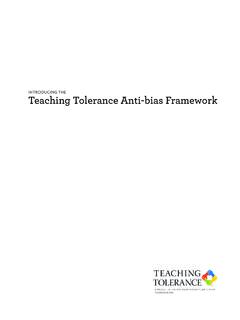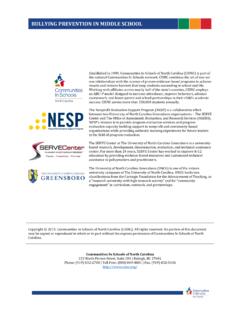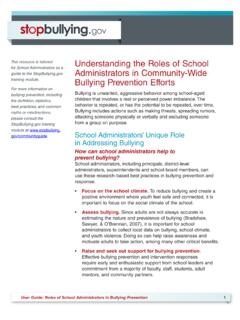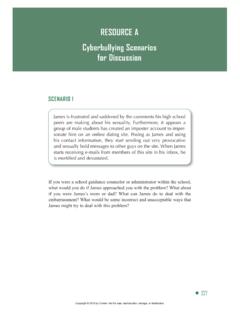Transcription of SPEAK UP AT SCHOOL - Learning for Justice
1 SPEAKUP AT SCHOOLA TEACHING TOLERANCE PUBLICATIONHow to Respond to Everyday Prejudice, Bias and StereotypesCONTENTSL etter from the Director 3 Introduction 4IN ADVANCEP repare Yourself 8 Prepare Your Students 12IN THE MOMENTB asic Strategies 18 The Dynamic 24 The Location
2 34 Putting It into Words 42 Putting It All Together 44 APPENDICESA For Students 48B Role-playing 49C Changing SCHOOL Policies and Taking Action 54D Resources 55 Acknowledgements 56 SPEAKUP AT SCHOOL2 3 Dear Educator, Many of the questions we receive for our magazine column Ask Teaching Tolerance are from educators seeking advice about how to respond when someone a student, a colleague.
3 Even a parent uses biased language or stereotypes in SCHOOL This booklet is our response It s for educators who want to develop the skills to SPEAK up themselves and who want to help their students find the courage to SPEAK up too What exactly is biased language, you might ask? Slurs, put-downs and other negative labels, of course We know these can start as early as kindergarten when, for instance, a boy is teased about being girly because he like dolls And we re all too familiar with the queasy feeling that comes when a colleague makes a joke that relies on stereotypes for its humor No single word covers all this ground In this guide, we refer to it as biased language, and to the larger problem as bias We know that many, if not most, of these remarks are said in ignorance.
4 But that some reflect real hostility This guide is for the adults in the SCHOOL It offers advice about how to respond to remarks made by students and by other adults and gives guidance for helping students learn to SPEAK up as well We believe that modeling the kind of behavior we want from students is one of the most effective ways of teaching it We also know that schools are hierarchies, for the adults and for the students So we ve addressed the ways responding to bias might be affected by the power relationship involved It s relatively easy for a teacher to correct a student who s used an ethnic slur, but quite uncomfortable even fearful to do so when the slur comes from a colleague, administrator or parent Finally, you ll notice that we talk a lot about moments in this guide We re talking about the very short time that passes when somebody says something and you struggle with how, or even whether.
5 You ll respond These moments are opportunities that must be acted on swiftly We hope this guide provides you with practical ideas about how to respond to biased language in the moment, from any source, in any situation Maureen CostelloTeaching Tolerance Director IN THE END, WE WILL REMEMBER NOT THE WORDS OF OUR ENEMIES, BUT THE SILENCE OF OUR FRIENDS. MARTIN LUTHER KING 5 You re tongue-tied Someone has said something biased that makes you uncomfortable, or even angry You want to say something, but you re not sure what to say It happens almost daily, one teacher relates Maybe it s one of your students Or it s a colleague Or an administrator And maybe you laugh along a forced or awkward laugh because you don t want to be rude You see students grappling with the same issues This guidebook offers tools and strategies to prepare you to SPEAK up against prejudice.
6 Bias and stereotypes at SCHOOL Because whoever it is, and wherever you are, there are ways to be ready for such moments, ways to make sure that you aren t caught tongue-tied, ways to make sure that you don t let hate have the last word NOTE This is not an anti- bullying guidebook, though the strategies can be used to address some forms of bullying behavior If you are implementing a specific anti- bullying curriculum in your SCHOOL or district, this guidebook can be used in concert with that effort If, for example, you are using the Olweus bullying Prevention Program, you can work with the Circle of bullying chart and use strategies in this guidebook to move Possible Defenders and even Disengaged Onlookers to genuine Defenders THERE YOU THE CLASSROOM.
7 IN THE CAFETERIA. ON A FIELD In AdvanceIn Advance 9 You re an educator You want to make the world a better place You want to create a SCHOOL environment that is safe and welcoming for all students and you don t want to let moments of bias pass silently But what to say? The best way to avoid being stymied when the moment occurs is to prepare Simply telling yourself that you are someone who will SPEAK up goes a long way toward shifting from inaction to action So say to yourself: I am a person who will SPEAK up against bigotry.
8 I will not let hate have the last next step is to develop ready responses that will work in a variety of moments That offends me. I don t find that funny. I m surprised to hear you say that. These phrases allow you to SPEAK up against bias in a simple, straightforward manner Sometimes they may open a dialogue Other times, they simply allow you to challenge bias and take a vocal stand against it Simple questions also are a good way to interrupt everyday bigotry What do you mean by that? Why would you say something like that?
9 What point are you trying to make by saying that? PREPARE YOURSELFQ uestions place a burden on the person who made the remark When faced with having to explain a joke or support a stereotype, people sometimes find themselves at a loss Follow up with a simple Tell me more to help the person move toward a deeper understanding of why the remark is offensive If the speaker falls back on something such as, C mon, I was just being funny, then you can use one of your ready responses, such as, I don t find that funny Practice the phrases aloud Memorize them Have them ready for the next moment The most important thing is to say something, says Deb Nielsen, a middle SCHOOL teacher in Durango, Colo Don t let these kinds of put-downs pass Put yourself out there, and you will make a difference Nielsen offers her own set of standard responses: Did you mean to say something hurtful when you said that?
10 Using that word as a put-down offends me. Using that word doesn t help others feel safe or accepted these in mind as well: How do you say it? You know you ll SPEAK up But what about tone and temperament? Veteran educators say it s best if you remain calm and thoughtful Don t react with shock Mostly, just 10 In AdvanceIn Advance 11be yourself Be firm Be confident Know that you are doing the right thing There is no need to shame or humiliate the other person; that tack too often works against you, galvanizing the behavior instead of changing it Humor is risky Sometimes it can defuse a tense situation Other times, though, it can send a mixed message Was something about the bigoted comment funny?
















